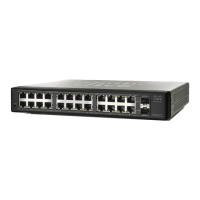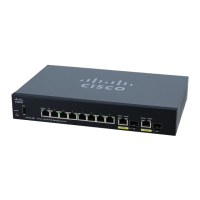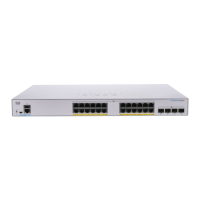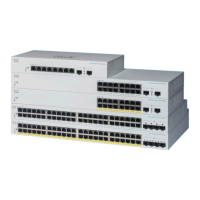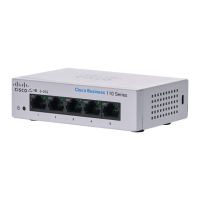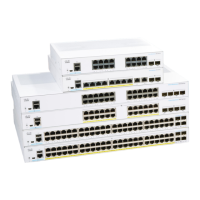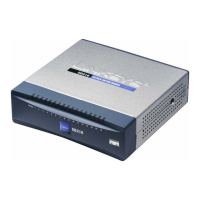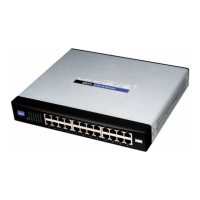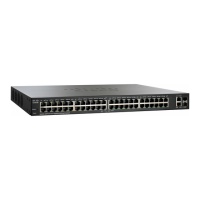
Do you have a question about the Cisco Small Business 200 Series and is the answer not in the manual?
| Layer | Layer 2 |
|---|---|
| Power over Ethernet (PoE) | Available on select models |
| Jumbo Frame Support | Up to 9216 bytes |
| Ports | 8 to 48 GE ports |
| MAC Address Table Size | 8K |
| VLAN Support | Yes |
| Quality of Service (QoS) | Yes |
| Security Features | ACLs, 802.1X authentication, port security |
| Management | Web-based GUI, CLI |
| Dimensions | Varies by model |
| Weight | Varies by model |
| Operating Temperature | 0° to 50°C (32° to 122°F) |
| Storage Temperature | -4°F to 158°F (-20°C to 70°C) |
| Humidity | 10% to 90% non-condensing |
Describes command keywords, parameters, and their usage, including mandatory and optional elements.
Explains symbols used in commands, such as italics for variables and brackets for optional parameters.
Groups commands by function and details prompts for different modes like Privileged EXEC and Global Config.
Lists common CLI error messages encountered during command execution, like invalid input or incomplete commands.
Details commands to manage Cisco Discovery Protocol (CDP), LLDP, or 802.1X protocol packet handling on the switch.
Explains commands for the Auto Configuration feature, enabling automatic download of network configuration files via DHCP.
Describes commands to configure port mirroring sessions for monitoring network traffic with a network analyzer.
Provides commands to perform hardware diagnostic tests on network ports and view results like cable status and length.
Covers commands for configuring Power-over-Ethernet (PoE) functionality on the switch, including power management and port settings.
Explains commands for securing switch management access via CLI, Web, or SNMP, covering authentication and user access.
Describes commands to configure the system clock manually or set up the switch as an SNTP client for time synchronization.
Commands for managing switch software and configuration files, including download, backup, delete, and save operations.
Provides commands to configure and view system logs, manage message buffering, and forward logs to a syslog server.
Commands to configure and view switch port capabilities, including auto-negotiation, MTU size, and port shutdown.
Explains commands for Green Ethernet power saving features, such as Energy Detect Mode and Short Reach Mode on gigabit ports.
Covers commands to enable flow control and storm control features to manage traffic and prevent network instability.
Details commands to configure Link Aggregation Groups (LAGs) for combining multiple Ethernet links into a single logical port.
Describes commands to create Virtual LANs (VLANs) and configure port VLAN memberships, including access and trunk modes.
Explains commands for configuring and displaying Link Layer Discovery Protocol for Media Endpoint Devices (LLDP-MED) information.
Covers commands to configure Auto-VoIP features, enabling identification and prioritization of voice traffic based on protocol or OUI.
Details commands to configure the Media VLAN feature, assigning priority to voice, video, and signaling traffic for separation.
Describes commands to display active and open TCP/UDP services, providing information on network connections and listening ports.
Explains commands for configuring RADIUS client functionality and servers, used for switch management access and 802.1X authentication.
Covers commands for implementing port-based access control using the IEEE 802.1X protocol for network access control.
Details commands to enable port security on a per-port basis, restricting traffic based on source MAC addresses.
Explains how to set maximum incoming traffic rates for ports and create rate limit profiles based on criteria and VLANs.
Covers commands to configure Class of Service (CoS) settings, controlling traffic priority and transmission rates using 802.1p, DSCP, or IP Precedence.
Describes commands to configure IPv4 and IPv6 addresses for the management interface and manage DHCP client settings.
Explains commands to configure DNS functionality, including hostname lookups, static mappings, and name server settings.
Covers commands to configure multicast forwarding properties and static multicast MAC address filters.
Details commands to configure the switch for snooping on Internet Group Management Protocol (IGMP) messages.
Explains commands to configure the switch for snooping on Multicast Listener Discovery Protocol (MLD) messages.


